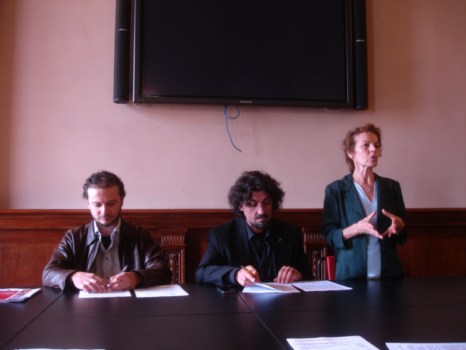Story and Photo by Anthony Savvides
On June 25, 2011, UNESCO declared the serial sites of “I Longobardi in Italia: I luoghi del potere” (Lombards in Italy: Places of the Power) a World Heritage Site (WHS) comprising of a total of seven groups of buildings throughout Italy. The acknowledgment of these monuments as a collective WHS increased Italy’s national count to 45. Yesterday afternoon, on September 27, at a town hall meeting here in Spoleto, plans to incorporate the Lombard sites in a new nationwide education initiative were discussed with members of the public and press. The panel included: Paolo Pacifici, the mayor of Campello sul Clitunno; BattistinaVargiu, the commissioner of education and training policies; and Giorgio Flamini, a member of the association of Spoleto.
The newly announced program, designated as “I Longobardi: un patrimonio commune alle radici della nostra cultura” (The Lombards: a common heritage of our culture’s roots), will spread knowledge and awareness about the ancient Lombard civilization and the role Lombards had in the formation of European culture within Italy. From 564-774 B.C., the Lombard Germanic tribes from northern Europe descended into Italy and controlled the region, then known as the Kingdom of Italy. Schools will not be required to enroll in the education program, but those districts that wish to participate must submit applications and proposals to the Ministry of Heritage and Culture and the Italian Lombard Association by October 15.
UNESCO declared a total of seven sites under the umbrella of the Italian Lombard WHS: the Basilica of San Salvatore in Spoleto; the Lombard Temple in Cividale del Friuli; the Temple of Clitunno in Campello; the church of Santa Sofia in Benevento; the Sanctuary of San Michele in Monte Sant’Angelo; the Monastery of San Salvatore and Santa Giulia in Brescia; and the Castle of Castelseprio-Torba. The Temple and Basilica of San Salvatore – in Campello sul Clitunno and Spoleto, respectively – are the two sites located within Umbria, and thus Campello and Spoleto are leading the regional ambition to participate in this unprecedented, sweeping education program.
The main feature will be school field trips, ranging anywhere from one to three days, during which middle school and high school students will be exposed to the cultural and historical significance of these ancient sites. Money will be loaned to participating classes to support the excursions; either 350, 800 or 1200 € will be awarded, depending on the length of the trip. The ultimate goal here is to immerse students in their own nation’s history, hopefully provided cultural enrichment and perhaps igniting a spark of interest in history, architecture, or anthropology.
While the main goal of the program is the education portion, Pacifici noted the importance of raising awareness among tourists as well. As mayor of Campello, he hopes that the sites within Umbria will be open at least five or six hours each day, as opposed to only during the aforementioned school trips. In Spoleto, the situation is slightly different, as the Basilica of San Salvatore is already a readily accessibly tourist attraction.
Now that these sites have increased importance and relevance to tourism throughout Umbria, and Italy on the whole, it is possible that entrance fees may be implemented. Those initiatives, however, would have to be overseen apart from the education portion of the program, as the sponsors hope to keep costs down for schools and students. The situation is further complicated by the ongoing recession, but a clearer picture will be drawn after submissions are made in mid-October.
Articolo correlato:





